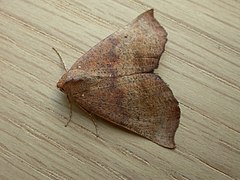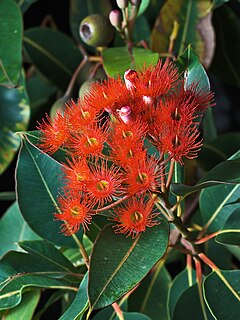
Corymbia is a genus of about 113 species of tree that were classified as Eucalyptus species until the mid-1990s. It includes the bloodwoods, ghost gums and spotted gums. The bloodwoods had been recognised as a distinct group within the large and diverse genus Eucalyptus since 1867. Molecular research in the 1990s, however, showed that they, along with the rest of the section Corymbia, are more closely related to Angophora than to Eucalyptus, and are probably best regarded as a separate genus. All three genera—Angophora, Corymbia and Eucalyptus—are closely related, often difficult to tell apart, and are still commonly and correctly referred to as "eucalypts". Groups of naturalists and conservationists do not recognise the genus Corymbia and still categorise its species within Eucalyptus.

Eucalyptus pauciflora, commonly known as snow gum or white sallee, is a species of flowering plant in the family Myrtaceae. It is a small tree or large shrub growing 4–8 m (13–26 ft) tall, occasionally reaching 20 m (66 ft), and native to subalpine and lowland habitats in eastern Australia. It is amongst the hardiest of all eucalyptus species, surviving the severe winter temperatures of the Australian Alps. Other common names include cabbage gum and weeping gum.

Opodiphthera eucalypti, the emperor gum moth, is a species of moth in the family Saturniidae native to Australia. This species was formerly placed in the genus Antheraea.
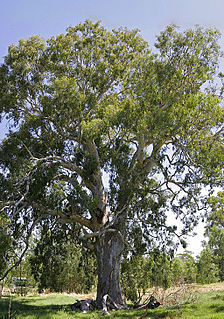
Eucalyptus camaldulensis, commonly known as the river red gum, is a tree that is endemic to Australia. It has smooth white or cream-coloured bark, lance-shaped or curved adult leaves, flower buds in groups of seven or nine, white flowers and hemispherical fruit with the valves extending beyond the rim. A familiar and iconic tree, it is seen along many watercourses across inland Australia, providing shade in the extreme temperatures of central Australia.

Eucalyptus ovata, commonly known as Swamp Gum or Black Gum, is a widespread occurring Australian eucalypt. The species was first described in 1806 by Jacques Labillardière in Novae Hollandiae plantarum specimen. The locality given in that work is "in terrâ Van-Leuwin", indicating Southwest Australia, but the species does not occur in that region.

Eucalyptus grandis, commonly known as the flooded gum or rose gum, is a tall tree with smooth bark, rough at the base fibrous or flaky, grey to grey-brown. At maturity, it reaches 50 metres tall, though the largest specimens can exceed 80 metres tall. It is found on coastal areas and sub-coastal ranges from Newcastle in New South Wales northwards to west of Daintree in Queensland, mainly on flat land and lower slopes, where it is the dominant tree of wet forests and on the margins of rain forests.

Eucalyptus leucoxylon, commonly known as yellow gum, blue gum or white ironbark, is a species of eucalypt that is endemic to Australia. It is widely distributed on plains and nearby mountain ranges or coastal South Australia, where it is known as the Blue Gum and extends into the western half of Victoria where it is known as the yellow gum.

Eucalyptus robusta, commonly known as swamp mahogany or swamp messmate, is a tree native to eastern Australia. Growing in swampy or waterlogged soils, it is up to 30 m (98 ft) high with thick spongy reddish brown bark and dark green broad leaves, which help form a dense canopy. The white to cream flowers appear in autumn and winter. The leaves are commonly eaten by insects, and are a food item for the koala. It is an important winter-flowering species in eastern Australia, and has been planted extensively in many countries around the world. Its timber is used for firewood and in general construction.

Eucalyptus tereticornis is a species of tree native to eastern Australia. E. tereticornis has several common names, including forest red gum, blue gum, flooded gum, grey gum, mountain gum, Queensland blue gum, red gum, bastard box, red ironbark, red irongum and slaty gum.

Eucalyptus rossii, commonly known as Inland Scribbly Gum, Western Scribbly Gum, Snappy Gum or White Gum, is a smooth-barked eucalypt of eastern Australia.
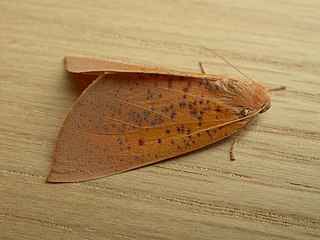
Plesanemma fucata, the lemon gum moth, is a moth of the family Geometridae. The species was first described by Rudolf Felder and Alois Friedrich Rogenhofer in 1875. It is found in the southern half of Australia.

Mnesampela lenaea, the rippled gum moth, is a moth of the family Geometridae first described by Edward Meyrick in 1892. It is found in Australia.
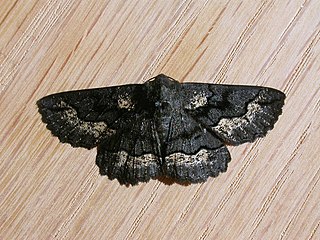
Melanodes is a monotypic moth genus in the family Geometridae. Its only species, Melanodes anthracitaria, the black geometrid, is found in Australia, more specifically in southern Queensland, New South Wales, Victoria, South Australia, and Tasmania. The genus and species were described by Achille Guenée in 1857.

Mnesampela is a genus of moths in the family Geometridae. It was described by Edward Guest in 1887.
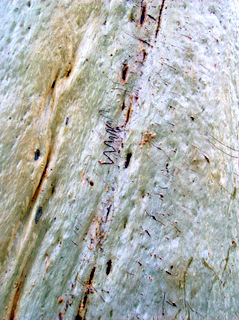
Eucalyptus racemosa, known as the scribbly gum or snappy gum, is a tree native to eastern Australia. An alternative name is narrow leaved scribbly gum, as the leaves are different from the related Eucalyptus haemastoma, a similar and better known tree.
Ogmograptis scribula, the scribbly gum moth, is a moth of the Bucculatricidae family. It is found in the Australian Capital Territory, New South Wales and Queensland.
Blue gum is a common name for subspecies or the species in Eucalyptus globulus complex, and also a number of other species of Eucalyptus in Australia. In Queensland it usually refers to Eucalyptus tereticornis, which is known elsewhere as forest red gum.
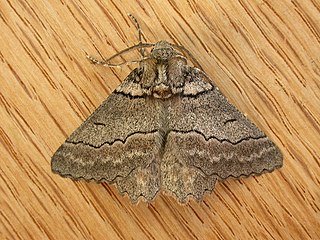
Hypobapta percomptaria, the southern grey, is a moth of the family Geometridae first described by Achille Guenée in 1857. It is known from Australia, including South Australia, New South Wales, Queensland, Victoria and Tasmania.
